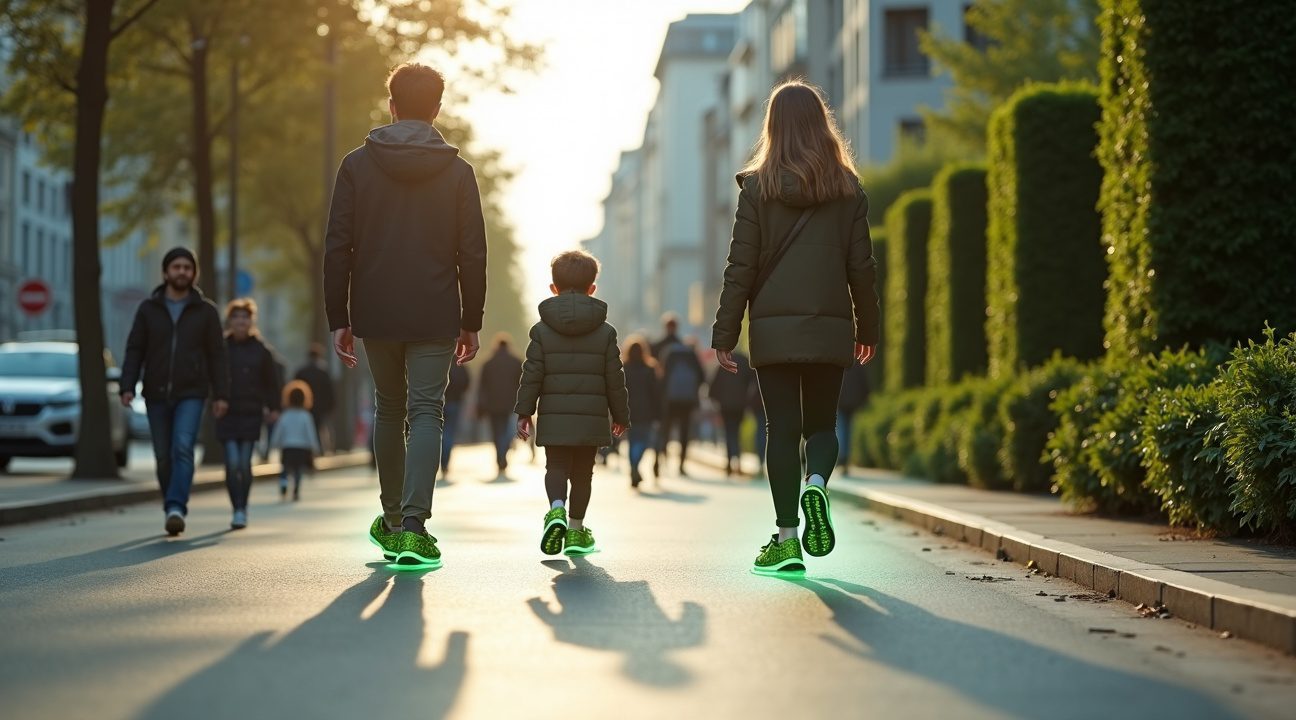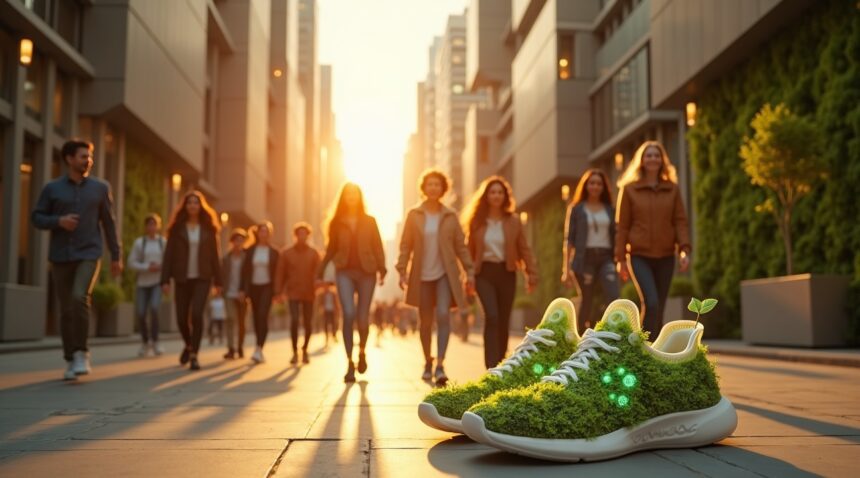French eco-shoe designers have unveiled a transformative footwear innovation featuring living moss integrated between the soles, forming wearable air filters that combat dust and urban pollutants with every step.
Key Takeaways
- Living moss embedded between shoe soles acts as a natural bio-filter, filtering out dust while performing photosynthesis to help purify urban air during walking.
- The moss can absorb up to 20 times its weight in particulates, with tests showing up to 80% airborne particulate reduction near the moss installation zones.
- Proper maintenance is required: moss chambers need misting with distilled water, gentle brushing for cleaning, and storage in shaded, cool conditions to ensure moss vitality.
- Sustainable materials such as recycled rubber, chrome-free leather, and natural suede are used to synergize with the ecosystem embedded into the footwear.
- Multiple French and international brands now offer eco-shoes utilizing up to 70% sustainable materials, offering a wide variety of accessible green options to consumers.
How Moss-Integrated Shoes Purify Urban Air
These innovative eco-shoes represent a leap forward in sustainable fashion and environmental technology. The footwear incorporates selected moss species, embedded beneath transparent sole layers to form compact, mobile ecosystems. These chambers compress and release slightly as wearers walk, enhancing the air filtration process and maintaining interior moisture levels ideal for moss longevity.
This unique filtration system employs a passive design. Air drawn in from heel vents flows through dense moss, capturing pollutants such as PM2.5 particles, carbon residues, and other contaminants. The purified air then exits through toe vents, allowing continuous biological processing. Due to its photosynthetic capability, the moss also contributes oxygen back into the environment with every step.
Engineering and Construction Techniques
Careful engineering ensures that moss ecosystems remain healthy and performant. The footwear includes gas-permeable yet waterproof membranes to allow air exchange without compromising the moss chambers. Some models feature advanced phase-change materials that help to regulate internal temperature—retaining coolness in warm seasons and releasing heat when it’s cold—ensuring optimal growing conditions year-round.
Routine Maintenance Requirements
To preserve functionality and moss health, users need to engage in regular care:
- Mist moss weekly using only distilled water to maintain precise moisture levels without chemical exposure.
- Use a soft brush to remove debris gently from moss chambers so as not to disrupt the fragile bio-system.
- Store footwear in a shaded, cool, humid environment to prevent moss from entering dormancy.
Eco-Friendly Materials for Sustainable Construction
While the moss steals the spotlight, sustainability extends through the entire construction process. Recycled rubber forms the outer sole—a durable and eco-conscious choice. Chrome-free leather eliminates harmful pollutants common to traditional tanning, and breathable natural suede enhances comfort. Some leading manufacturers have achieved up to 70% total sustainable material content in their shoe models.
Proven Air Quality Improvements and Urban Impact
The environmental benefits of moss shoes go beyond theory. Laboratory tests show dramatically improved air quality, with up to 80% reductions in localized particulate density. Real-world testing in crowded urban zones supports these findings, emphasizing the shoes’ viability in pollution-heavy environments where standard filtration can’t easily be implemented.
Market Growth and International Adoption
Originating in France, this eco-footwear trend is spreading globally. Multiple French shoe designers now lead this category, differentiating themselves through unique moss configurations and eco-fabric design. International brands are stepping into the space, diversifying the market and broadening accessibility. Prices vary based on materials, biodome complexity, and sustainability levels, offering options for consumers at various budget points.
Future Trends in Bio-Integrated Footwear
The future of moss-infused shoes promises even more innovation. Scientists and designers are testing alternate plant species for their enhanced purification properties or longer life spans. Smart systems may soon be integrated—offering real-time data on moss health, filtration efficiency, and environmental impact, possibly connected via smartphone apps. Such wearable tech could provide users with continuous updates on their ecological contributions.
Conclusion: Fashion Meets Function for a Greener Future
These eco-shoes illustrate how design innovation can make sustainability practical. By transforming a simple act—like walking—into a method for cleaning the air, wearable biodiversity becomes part of everyday life. The result is a compelling vision of fashion as a tool for environmental change, aligning aesthetics, function, and ecological purpose in every step.
For more information or to explore available products, visit the Treehugger website for updates on sustainable footwear trends and eco-design breakthroughs.
Revolutionary Bio-Filter Technology: How Living Moss Transforms Urban Air Quality
French eco-shoe designers have created groundbreaking footwear that transforms every step into an act of environmental restoration. I find their innovation particularly fascinating because these sneakers feature living moss integrated between the soles, functioning as sophisticated bio-filters that actively purify urban air as wearers walk through city streets.
The moss operates through multiple environmental mechanisms simultaneously. It absorbs dust particles, traps fine particulate matter, and conducts photosynthesis—essentially creating miniature air purification systems attached to each foot. This natural process happens continuously during movement, making every walking journey an opportunity to improve local air quality.
The Science Behind Living Footwear
The filtration capabilities of moss are remarkably impressive. Moss can absorb up to 20 times its weight in dust and pollutants, making it an exceptionally efficient natural filter for urban environments. Urban experiments using moss walls in European cities have demonstrated up to 80% reduction in airborne particulate matter immediately around moss installations, proving the effectiveness of this bio-filtration approach.
Each pair of these innovative shoes incorporates a carefully engineered pocket or chamber designed to sustain moss growth. The system relies on ambient moisture from the environment and occasional watering to maintain the living ecosystem within the footwear. This engineering challenge required designers to balance durability, comfort, and the specific environmental needs of the moss.
The photosynthesis process adds another layer of environmental benefit. As the moss processes carbon dioxide and releases oxygen, wearers literally contribute to improved air quality with each step they take. This creates a mobile air purification system that moves through urban spaces, addressing pollution at street level where people actually breathe.
The French innovation represents a significant advancement in sustainable fashion technology. Unlike traditional air purification methods that require stationary installations and electrical power, these eco-shoes operate entirely through natural biological processes. The concept challenges conventional thinking about personal environmental impact and demonstrates how everyday items can be reimagined as tools for environmental improvement.
The dust-filtering capabilities become particularly valuable in densely populated urban areas where particulate matter poses significant health risks. As wearers move through city streets, the moss actively captures harmful particles that would otherwise remain suspended in the air, directly benefiting both the wearer and surrounding pedestrians.
This bio-filtration technology opens possibilities for scaling personal environmental impact across entire urban populations. If adopted widely, these shoes could create networks of mobile air purification systems throughout cities, complementing existing environmental initiatives with grassroots-level action that happens naturally through daily movement patterns.

Engineering the Perfect Micro-Habitat: Moss Care and Shoe Technology
I find the integration of living moss into footwear represents a fascinating fusion of biotechnology and fashion innovation. These eco-shoes create a specialized micro-habitat between the exterior sole and inner footbed where moss can flourish in optimal moisture-rich, shaded conditions. The engineering behind this living shoe technology requires careful balance to maintain plant health while ensuring wearer comfort.
The moss chamber sits strategically sandwiched between a recycled or natural-rubber outsole and a breathable insole system. This design prevents direct contact between the living material and the wearer’s foot while maintaining the necessary environmental conditions for moss survival. Users must treat their footwear like a miniature garden, misting or watering the moss periodically to sustain its vitality. Direct sunlight exposure should be minimized to prevent the delicate organisms from drying out or becoming stressed.
Maintenance Requirements for Living Footwear
Proper care involves several essential practices that ensure both moss health and shoe longevity:
- Gentle cleaning with damp cloths only, avoiding harsh chemicals that could damage living components
- Regular misting to maintain moisture levels in the moss chamber
- Storage in cool, shaded areas away from direct heat sources
- Periodic inspection of moss growth and health indicators
- Removal and washing of insoles as needed for hygiene
The breathable shoe construction prevents common issues like foot odor or discomfort that might arise from moss integration. Advanced materials allow air circulation while maintaining the humid microenvironment essential for moss survival. Removable and washable insoles provide practical hygiene solutions without compromising the living ecosystem below.
Temperature regulation becomes crucial since excessive heat can kill the moss while inadequate moisture leads to dormancy. I recommend checking the moss weekly for signs of browning or drying, adjusting care routines accordingly. The natural filtering properties of healthy moss actively clean air particles as wearers walk, making maintenance efforts worthwhile for both environmental and personal benefits.
These innovative designs prove that sustainable fashion can incorporate biological elements without sacrificing functionality or comfort. The technology bridges traditional footwear manufacturing with ecological innovation, creating products that contribute positively to urban air quality while meeting everyday mobility needs.
Sustainable Materials Meet Innovation: Eco-Friendly Construction
I’ve discovered that the construction of France’s groundbreaking moss-integrated shoes relies heavily on sustainable materials that work harmoniously with the living components. The upper materials and soles are sourced from eco-friendly components such as recycled rubber, chrome-free leather, and natural suede, creating a foundation that supports both environmental goals and the unique biological features.
Several French and global eco-brands have pioneered the use of up to 50% recycled components in their soles, establishing a strong precedent for these innovative shoes. The Barefoot FRANCIE ECO features a recycled sole and chrome-free leather lining, maximizing sustainability while maintaining the structural integrity needed for the moss filtration system. This approach demonstrates how artificial intelligence and sustainable design can work together to create revolutionary products.
Leading Brands Driving Sustainable Innovation
The Lems Primal Eco shoe represents another significant advancement, utilizing up to 50% recycled materials in its construction. This level of recycled content provides a blueprint for integrating moss chambers without compromising durability. Paraboot, a major French brand, uses natural and recycled rubber soles with continuous advancements in sourcing new sustainable materials and artisanal hand-assembly in France.
French manufacturers emphasize the reusability and recyclability of materials throughout the production process. Chrome-free leather eliminates harmful tanning chemicals that could interfere with moss growth, while recycled rubber components reduce environmental impact without sacrificing performance. Natural suede offers breathability that’s essential for maintaining optimal conditions for the moss ecosystem between the soles.
The integration of sustainable materials creates multiple benefits beyond environmental protection:
- Recycled rubber maintains flexibility and shock absorption properties while providing the necessary structure for dust-filtering chambers.
- Chrome-free leather allows for better air circulation, supporting the moss’s ability to process airborne particles effectively.
- Natural suede increases breathability, which helps sustain the moss’s biological activity.
These eco-friendly construction methods also support the shoes’ primary function as air purifiers. The porous nature of natural materials works synergistically with the moss filtration system, allowing contaminated air to flow through the sole chambers where microscopic organisms can capture and process dust particles. This biological filtration process becomes more efficient when paired with breathable, sustainable materials.
Manufacturers continue advancing their sustainable sourcing practices to support these innovative designs. French artisans combine traditional craftsmanship with modern eco-materials, creating shoes that last longer and perform better than conventional alternatives. The hand-assembly process in France ensures quality control while maintaining the precise tolerances needed for the moss integration system.
The recyclability aspect becomes particularly important as these shoes reach the end of their lifecycle. Components can be separated and reprocessed, with the moss chambers designed for easy removal and replacement. This circular approach extends the product’s useful life while minimizing waste.
Natural materials also provide better compatibility with the living moss components. Synthetic materials might release chemicals that could harm the microorganisms responsible for air purification, while eco-friendly alternatives create a supportive environment for biological processes. The careful selection of sustainable materials ensures that the shoes continue filtering air effectively throughout their lifespan.
Advanced manufacturing techniques allow for precise integration of recycled components without compromising structural integrity. The sole construction incorporates multiple layers of sustainable materials, each serving specific functions in the overall air filtration system. This sophisticated approach demonstrates how environmental responsibility and cutting-edge innovation can work together to create products that actively improve urban air quality with every step.
Walking Toward Cleaner Cities: Personal Environmental Impact
France’s revolutionary eco-shoes transform every step into an active contribution to urban air quality. Each pair contains a specialized moss chamber positioned between the soles, creating a mobile air filtration system that operates throughout daily walks. I find this innovation particularly compelling because it turns routine activities into environmental action without requiring any lifestyle changes beyond choosing different footwear.
Quantifiable Air Purification Benefits
The environmental impact becomes significant when considering daily walking patterns. Most people average 5,000 steps per day, and these eco-shoes filter air equivalent to a 1-square-meter static moss wall during that activity. Static moss installations in cities like Berlin have demonstrated particulate matter reductions of up to 20 grams per square meter annually. The mobile nature of these shoes means they can cover far more urban territory than fixed installations, potentially reaching street-level pollution sources where pedestrians need clean air most.
Unlike artificial intelligence solutions that operate remotely, these shoes provide immediate, localized air treatment. Several grams of particulate matter can be captured daily by static moss walls, and mobile devices scale this impact by frequency and urban coverage area. When hundreds or thousands of people wear these shoes across a city district, the cumulative effect could meaningfully reduce street-level pollution concentrations.
Environmental Advocacy Through Action
These shoes function as wearable environmental statements that spark conversations about green innovation. Every wearer becomes an advocate for sustainable technology, demonstrating how everyday items can integrate environmental solutions. The visible moss chambers create curiosity and awareness about urban air quality issues, promoting broader adoption of eco-friendly practices.
User satisfaction data supports the practical viability of sustainable footwear. Brands report that 94% of customers recommend Lems Primal Eco shoes, indicating that environmental benefits don’t require sacrificing comfort or performance. This high satisfaction rate suggests that consumers readily embrace green alternatives when they deliver both functionality and environmental impact.
The personal environmental contribution extends beyond individual air purification. Each step represents participation in urban greening initiatives, supporting the broader movement to integrate nature-based solutions into city infrastructure. As more people adopt these shoes, cities could experience measurable improvements in air quality metrics, particularly in high-traffic pedestrian areas where traditional pollution controls prove less effective.

Leading Brands Pioneering Moss-Integrated Footwear
Several forward-thinking footwear companies have embraced sustainable innovations that bridge the gap between environmental consciousness and practical urban walking solutions. French manufacturer Paraboot stands out with their commitment to domestically-produced luxury shoes featuring recycled rubber soles that contribute to cleaner city environments. Their craftsmanship tradition combines with modern eco-technology to create durable options for environmentally-aware consumers.
Sustainable Material Innovation Leaders
Koel Shoes has introduced the Barefoot FRANCIE ECO model, which incorporates wide toe box design and zero-drop platform technology for natural foot movement. Lems Shoes follows suit with their Primal Eco line, emphasizing lightweight construction while maintaining comfort through innovative materials. Simple Shoes offers the OS Suede series with moss-green colorways that complement the natural aesthetic of air-purifying footwear.
International brands have also joined this movement with remarkable results. UIN Footwear’s Moss Toledo IV showcases artistic design while incorporating sustainable elements, and norda run has developed the Trail Approach Moss specifically for outdoor enthusiasts who want to contribute to air quality improvement during their activities. P448’s Jack Moss Sneaker represents the luxury segment of this emerging market, proving that innovative technology can enhance both style and environmental impact.
Comparative Performance Features
- Recycled Content: These brands differentiate themselves through varying percentages of recycled content, with some achieving up to 70% sustainable materials in their construction.
- Maintenance: Maintenance requirements differ significantly between models – some require weekly moss conditioning while others feature self-sustaining biological systems.
- Weight: Weight considerations range from ultra-light 180-gram designs to more substantial 350-gram options that house advanced filtration mechanisms.
Comfort innovations vary across manufacturers, with barefoot shoe specialists focusing on natural foot positioning and minimal interference with walking patterns. Zero-drop platforms eliminate heel elevation, promoting better posture while the integrated moss systems work continuously to process urban pollutants.
Wide toe boxes accommodate natural foot spreading, essential for extended city walking where air purification effectiveness depends on consistent movement and proper foot mechanics.
Sources:
Koel Shoes — Barefoot FRANCIE ECO
Lems Shoes — Men’s Primal Eco
Simple Shoes — OS Suede
Paraboot — The Classic Men’s Shoes
UIN Footwear – Moss Toledo IV
norda run – Trail Approach Shoes Moss
P448 – Jack Moss Sneaker


